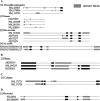Bioinformatic analysis of the four transcription factors used to induce pluripotent stem cells
- PMID: 24129607
- PMCID: PMC4235945
- DOI: 10.1007/s10616-013-9649-0
Bioinformatic analysis of the four transcription factors used to induce pluripotent stem cells
Abstract
Induced pluripotent stem (iPS) cells are a type of pluripotent stem cell artificially derived from non-pluripotent cells by overexpressing the transcription factors Oct4, Sox2, Klf4 and Nanog. These transcription factors play a pivotal role in stem cells; however, the function of these factors are not fully characterized. In this study, we analyzed Oct4, Sox2, Klf4 and Nanog in ten different species using bioinformatics, to provide more knowledge of the function of these genes. Nanog does not exist in the invertebrates Caenorhabditis elegans and Drosophila melanogaster, indicating that the absence of Nanog may be responsible for the developmental differences between vertebrates and invertebrates. Construction of phylogenetic trees confirmed that the function of Nanog is conserved from fish to mammals. The effect of alternative splicing on the protein domains present in Oct4, Sox2, Klf4 and Nanog were also analyzed. Examination of the expression patterns in human stem cells, iPS cells and normal tissues showed that Oct4, Sox2, Klf4 and Nanog are expressed at similar levels in iPS cells and embryonic stem cells, and expression of all four transcription factors decreases after differentiation. Expression of Klf4 reduced to the least during differentiation, and Klf4 was found to be specifically expressed in several normal tissues, especially the salivary gland. In this paper, we systematically indentified the family proteins of the four transcription factors used to induce pluripotent stem cells, and then analyzed their evolution status, composed of those protein domains, alternative splicing translation, expression status and interaction networks. Those analysis could shed a light for further research of iPS.
Figures











Similar articles
-
Generation of human-induced pluripotent stem cells from gut mesentery-derived cells by ectopic expression of OCT4/SOX2/NANOG.Cell Reprogram. 2010 Jun;12(3):237-47. doi: 10.1089/cell.2009.0103. Cell Reprogram. 2010. PMID: 20698766
-
Klf4 interacts directly with Oct4 and Sox2 to promote reprogramming.Stem Cells. 2009 Dec;27(12):2969-78. doi: 10.1002/stem.231. Stem Cells. 2009. PMID: 19816951
-
Cancer Stem Cell Subpopulations Are Present Within Metastatic Head and Neck Cutaneous Squamous Cell Carcinoma.Front Oncol. 2020 Jul 30;10:1091. doi: 10.3389/fonc.2020.01091. eCollection 2020. Front Oncol. 2020. PMID: 32850316 Free PMC article.
-
Crosstalks between Raf-kinase inhibitor protein and cancer stem cell transcription factors (Oct4, KLF4, Sox2, Nanog).Tumour Biol. 2017 Apr;39(4):1010428317692253. doi: 10.1177/1010428317692253. Tumour Biol. 2017. PMID: 28378634 Review.
-
Transcription factors for the modulation of pluripotency and reprogramming.Cold Spring Harb Symp Quant Biol. 2010;75:237-44. doi: 10.1101/sqb.2010.75.003. Epub 2010 Nov 3. Cold Spring Harb Symp Quant Biol. 2010. PMID: 21047904 Review.
Cited by
-
Application of the Yamanaka Transcription Factors Oct4, Sox2, Klf4, and c-Myc from the Laboratory to the Clinic.Genes (Basel). 2023 Aug 26;14(9):1697. doi: 10.3390/genes14091697. Genes (Basel). 2023. PMID: 37761837 Free PMC article. Review.
-
The developmental and evolutionary origins of cellular pluripotency in the vertebrate neural crest.Semin Cell Dev Biol. 2023 Mar 30;138:36-44. doi: 10.1016/j.semcdb.2022.04.008. Epub 2022 May 6. Semin Cell Dev Biol. 2023. PMID: 35534333 Free PMC article. Review.
-
Bioinformatic analysis identifies potentially key differentially expressed genes in oncogenesis and progression of clear cell renal cell carcinoma.PeerJ. 2019 Nov 26;7:e8096. doi: 10.7717/peerj.8096. eCollection 2019. PeerJ. 2019. PMID: 31788359 Free PMC article.
References
-
- Andersen B, Rosenfeld MG. POU domain factors in the neuroendocrine system: lessons from developmental biology provide insights into human disease. Endocr Rev. 2001;22:2–35. - PubMed
LinkOut - more resources
Full Text Sources
Other Literature Sources
Research Materials

